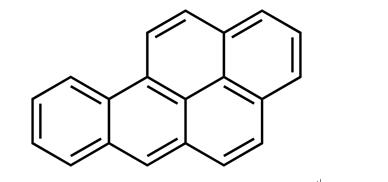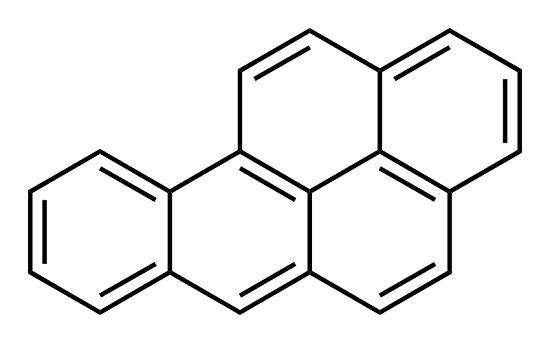What you should know about Benzo[a]pyrene?
Benzo[a]pyrene (B[a]P) is one of a large number of polycyclic aromatic hydrocarbons (PAHs) that are formed during the incomplete combustion of organic matter. It is the most well-studied PAH, a cancer-inducing substance for which toxicological data serve as quantitative benchmarks for the entire carcinogenic subgroup [1].Benzo[a]pyrene is a polycyclic aromatic hydrocarbon and the result of incomplete combustion of organic matter at temperatures between 300 °C (572 °F) and 600 °C (1,112 °F). The substance with the formula C20H12 is one of the benzopyrenes, formed by a benzene ring fused to pyrene. Its diol epoxide metabolites (more commonly known as BPDE) react and bind to DNA, resulting in mutations and eventually cancer. It is listed as a Group 1 carcinogen by the IARC. In the 18th century a scrotal cancer of chimney sweepers, the chimney sweeps' carcinoma, was already known to be connected to soot [2].

(1) Where can benzo(a)pyrene be found and how is it used?
Benzo(a)pyrene is found in nature from the eruption of volcanoes and forest fires. Yet this chemical compound is also man-made. Benzo(a)pyrene can be found in surface water, tap water, rainwater, groundwater, wastewater and sewage sludge. Man-made releases of benzo(a)pyrene are to the air, where sunlight turns the chemical into a dry form that falls to the ground and breaks down in the soil. This chemical results from burning plants, wood, coal, and operating cars, trucks and other vehicles. The major indoor sources of benzo(a)pyrene in the air are wood-burning fireplaces and stoves, and tobacco smoking. There is no known industry production or use of benzo(a)pyrene.
(2) How can people be exposed to benzo(a)pyrene?
You could be exposed to benzo(a)pyrene through:
Breathing air containing benzo(a)pyrene in the workplace. This can occur if you work in coking, coal-tar and asphalt production plants, or in smokehouses or where local trash is burned. You can also breathe benzo(a)pyrene from cigarette smoke, wood smoke, vehicle exhaust, asphalt roads or smoke from burning farm plants.
Contact with benzo(a)pyrene in the air, water, or soil near a waste site, or another polluted site.
Eating grilled or charred meats. You can also be exposed through contaminated cereals, flour, bread,vegetables, fruits, meats; and processed or pickled foods.
Drinking contaminated water or cow’s milk. Nursing infants may be exposed through breast milk, especially if the mother lives near a waste site containing benzo(a)pyrene [3].
(3) How does benzo(a)pyrene work and how can it affect my health?
Benzo[a]pyrene is metabolized by both phase-I and phase-II enzymes to form a series of arene oxides, dihydrodiols, phenols, and quinones and their polar conjugates with glutathione, sulfate, and glucuronide (Osborne & Crosby, 1987) [4].
Short-term health effects can be a skin rash or eye irritation with redness and/or a burning sensation. Exposure to sunlight and the chemical together can increase these effects.
Long-term health effects can be deadly. Benzo[a]pyrene is a probable cancer-causing agent in humans.There is some evidence that it causes skin, lung, and bladder cancer in humans and in animals. If benzo(a)pyrene is on your skin when you are being exposed to sunlight or ultraviolet light, the risk of skin cancer is greater. Exposure to coal tar and pitch increases the likelihood of cancer. Repeated exposure to substances containing benzo[a]pyrene may cause the skin to thicken and darken, and for pimples to appear. Long-term skin changes include both loss of color and reddish areas, thinning of the skin and warts. Bronchitis may result from repeated exposure to mixtures containing benzo(a)pyrene. What should I do if exposed to benzo(a)pyrene?
Anyone who may have been exposed to high levels of benzo(a)pyrene should be removed from the source of exposure immediately. Clothing in contact with benzo(a)pyrene should be removed and discarded. Skin and eyes exposed to benzo(a)pyrene should be flushed with clean water for at least 15 minutes. Seek medical attention immediately [3].
References
[1] Williams, Marc A. , C. Salice , and G. Reddy . "Chapter 24 – Wildlife Toxicity Assessment for Benzo[a]Pyrene." Wildlife Toxicity Assessments for Chemicals of Military Concern(2015):421-437.
[2] https://www.ebi.ac.uk/chebi/searchId.do?chebiId=CHEBI:29865
[3] https://www.dhss.delaware.gov/dph/files/benzopyrenefaq.pdf
[4] https://www.ncbi.nlm.nih.gov/books/NBK304415
[5] https://pubs.acs.org/doi/full/10.1021/es990817w
[6]https://echa.europa.eu/documents/10162/13638/msc_svhc_supdoc_benzo-ghi-perylene_en.pdf/80887e3e-0a91-cff7-ad2c-c1e4690ffbd4
You may like
Related articles And Qustion
See also
Lastest Price from Benzo[a]pyrene manufacturers
![50-32-8 Benzo[a]pyrene](/ProductImageEN/2021-07/Small/5d8f327e-90ff-437b-8a85-1d904e00cefa.jpg)
US $15.00-10.00/KG2021-07-13
- CAS:
- 50-32-8
- Min. Order:
- 1KG
- Purity:
- 99%+ HPLC
- Supply Ability:
- Monthly supply of 1 ton
![50-32-8 Benzo[a]pyrene](/ProductImageEN/2021-07/Small/f4d8db00-0f52-48f3-8301-c724d45010bd.jpg)
US $15.00-10.00/KG2021-07-10
- CAS:
- 50-32-8
- Min. Order:
- 1KG
- Purity:
- 99%+ HPLC
- Supply Ability:
- Monthly supply of 1 ton
![50-32-8 Benzo[a]pyrene; PAHs; carcinogen; exposure](https://www.chemicalbook.com/CAS/GIF/50-32-8.gif)
